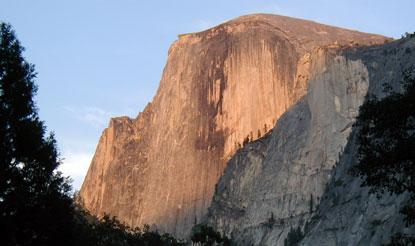Getting up Half Dome in Yosemite National Park got a little easier this past weekend. That's because the cables that give you something to hold onto as you scale the shoulder of the dome were put up for the season.
While the cables do make the hike to the top much easier, they don't make it that much less intimidating.
The Half Dome hike is a round-trip hike of over 17 miles and is considered extremely strenuous. Hikers gain 4,800 feet of elevation along the way as they pass highlights such as Vernal Fall and Nevada Fall, before reaching the cables on Half Dome’s steep granite shoulder. A series of metal cables are placed along the steep shoulder of the dome to assist hikers to the summit.
This hike is not for the timid. The National Park Service urges you to take appropriate precautions when planning a hike of this length and difficulty, and to be prepared for changing weather and trail conditions. Thunder and lightening are common occurrences in the High Sierra during the summer and fall; hikers should not to attempt to summit Half Dome around or during thunderstorms and are advised to use extreme caution when the rocks are wet.




Comments
Half Dome is now open for business!! Reports from the first wave of hikers say that there is still a patch of snow on the summit and the caterpillar lines are back for another season! Leave early! Be sure to treat your water - Giardia reside in the natural sources. Good ankle high boots are recommended and using hiking poles will ease your uphill and save your knees on the downhill.
Have fun!
Rick D
And don't forget to take a pair of work gloves, unless you prefer to donate skin onto those steel cables, especially on your way back down!
Don't they still have that stash of gloves at the base of the cables?
On a busy day, the stash of gloves is all claimed. I've heard rumors that now and then they are determined to be "litter" and carried off by park personnel. Better bring your own.
Gloves and Trash
"Many people find gloves helpful on the cables. However, if you bring your gloves up, pack them out. Hundreds of pounds of rotting gloves otherwise accummulate."
(didn't know accumulate had 2 M's :-))
Here's the story on the gloves. They are in a word: junk. They are discarded by previous hikers and are indeed considered trash by the park service. Some people even think the NPS puts them there. They are oversized, torn, moldy (yes, sitting there for weeks tends to grow funk) and potential carriers of the affliction “mogo on the gagogo.” The point is, bring your own tight fitting – good gripping – gloves. I wear bike gloves all day as I use hiking poles and they prevent blisters. Once on the cables you need max grip. The man above is right. Coming down you will be sliding the cables across your palms just asking for blisters.
Rick D.